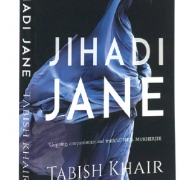
Etcetera

Tabish Khair goes behind the headlines to give us a poignant peep into the heads and hearts of youngsters who are radicalised for the ‘exalted’ cause of faith. Gripping from the word go, JIHADI JANE (Penguin; ₹ 299; 240 pages) paints a heart-wrenching picture of militant brides operating around the world and the terrifying cost of religious fanaticism. Told through the story of two British Muslim girls, Jamilla and Ameena, who run away to Syria to join the Islamic State, the moving narrative exposes the magnetism as well as hypocrisy of ruthless religious movements. The author convincingly portrays the transformation of Ameena, a quasi-rebel who smokes, indulges in casual sex and wears jeans, into a devout Muslim, wearing loose clothes, immersing herself in the Quran and objecting to the presence of pork-eating friends at her place. However, Ameena seldom speaks in the book; we hear her voice through Jamilla, the narrator. The book lays bare the brainwashing and recruitment of youngsters through social media. Khair exposes the multiple causes at work here, from blind faith and dysfunctional families to the desire for an exotic getaway from the drudgery of commonplace existence. Though a work of fiction, it sounds so realistic that it could hold true as the untold story of countless nameless jihadis.
For most of us, Arthur Conan Doyle’s name is synonymous with the adventures of
Sherlock Holmes. Doyle’s oeuvre, however, comprised historical adventures, science fiction and short stories that are largely overlooked in favour of the mysteries starring the legendary private detective. THE CASE OF LADY SANNOX (Speaking Tiger; ₹ 250; 230 pages) brings together some of these lesser known stories. Most of these are medical mysteries, reminding us that Doyle was first and foremost a physician. While the title story revolves around a flamboyant surgeon’s adulterous affair, “A False Start” examines a young doctor’s struggles to attract patients. For those who are good at picking up clues, it’s easy to see traces of elements in the anthology that would define the world of Holmes, including the introduction of Mrs Hudson in “Behind the Times”, the landlady
Featured in Harmony — Celebrate Age Magazine February 2017
No other Indian epic has been told and retold as many times as The Mahabharata. In THE SERPENT’S REVENGE: UNUSUAL TALES FROM THE MAHABHARATA (Puffin; ₹ 250; 182 pages), prolific writer Sudha Murty reintroduces India’s greatest epic through some little-known extraordinary tales, which are now mostly relegated to regional folklore. Thus, we are introduced to the tale of the king of Udupi who, instead of taking sides, ran a kitchen to feed the soldiers of both armies during the epic war at Kurukshetra, earning a blessing from Krishna that his future generations would be known for making and serving delicious meals—yes, here we have the origin of the ubiquitous Udupi restaurant! Another regional story that has spawned many dance and puppet shows in Karnataka and Andhra Pradesh, but is largely unknown to a pan-Indian audience, is that of the romance between Shashirekha, daughter of Krishna’s brother Balarama, and legendary warrior Abhimanyu. Though the wisdom of the epic permeates this collection, the little nuggets that accompany most stories as footnotes, connecting present-day places and rituals with happenings narrated in the epic, are the gems, a strategy designed to lure the modern reader.
At a time when reports are saying humans will be having more sex with bots than each other by 2050, Yuval Noah Harari’s HOMO DEUS: A BRIEF HISTORY OF TOMORROW (Penguin; ₹ 799; 440 pages) is a timely reminder of the way things are headed. It’s a world where wars are obsolete and Homo Sapiens, who have upgraded to Homo Deus—by acquiring the powers of creation and destruction—are more likely to commit suicide than be killed in a conflict. It’s a world where famine is a thing of the past, and the human population is more at a risk of obesity than starvation. It’s an age where death is just a technical problem. The author of Sapiens: A Brief History of Humankind foresees a not-too-distant world in which we face a new set of challenges. With his trademark blend of science, history, philosophy and every discipline in between, Harari explores the projects, dreams and nightmares that will shape the 21st century—from overcoming death to creating artificial life. It all sounds plausible given that the flagship enterprise of modern science is to defeat death and grant humans eternal youth. To quote Harari, “Homo Sapiens is likely to upgrade itself step by step, merging with robots and computers in the process, until our descendants will look back and realise that they are no longer the kind of animal that wrote the Bible, built the Great Wall of China and laughed at Charlie Chaplin’s antics.”
Featured in Harmony — Celebrate Age Magazine January 2017
They say distance gives perspective…but there’s no perspective like the complete outsider looking in. Take Murray Laurence—traveller, writer, teacher and, above all, India aficionado. Between the 1970s and the 2000s, ‘Laurence of Australia’ returned to India over 10 times, and each time he was struck by the mayhem! After the 2008 Mumbai terror attacks, when he happened to be in the metropolis, he poignantly observed, “India would never be the same again. But in reality, India has never been the ‘same again’ at any time.” In his new book, SUBCONTINENTAL DRIFT: FOUR DECADES ADRIFT IN INDIA & BEYOND (Aleph, ₹ 399, 228 pages), “the original backpacker” takes us back to simpler, yet much more complicated, times when travellers had to deal with ‘tourist assistance officers’. Mind you, there was no IRCTC or Cleartrip then. And with no online forums to warn him, Laurence had to experience firsthand the many gifts India kept giving—from the healing properties of cow urine to encounters with touts offering up their bodies to be hit with a chappal, for a price! It’s hilarious; the way Laurence narrates these outrageous encounters is so matter-of-fact, you can sense he is bemused, but not surprised. He evidently knows India in ways we don’t.
He has always had a taste for the macabre. Written in inimitable Ruskin Bond style, WHISPERS IN THE DARK: A BOOK OF SPOOKS (Puffin; ₹ 250; 234 pages) has an eerie but eclectic cast comprising Jimmy the jinn who has trouble keeping his hands to himself, the pisach and churel who live in the peepul tree, and a bloodthirsty vampire cat, among others. If you are a regular reader of Bond, you might already be acquainted with the faceless schoolboy ghost on the hill or the buffalo demons. That in no way takes away from the thrill of encountering them yet again. Graphic illustrations accompany every tale. In one of the stories, Bond writes, “The villages of India have always harboured a large variety of ghosts, some of them good, some evil. There are the prets and bhoots, both the spirits of dead men, and the churels, ghosts of women who change their shape after death.” He doesn’t forget to add though, in classic Bond style, “One thing they have in common: nearly all of them choose to live in the peepul tree.”
Featured in Harmony — Celebrate Age Magazine December 2016
From Harappan times, when India engaged in maritime trade with civilisations thousands of miles away, to the recent Chinese interest in expanding its presence in neighbouring ports including Gwadar, the Indian Ocean has dominated the geopolitical reality of the region. Sanjeev Sanyal’s THE OCEAN OF CHURN: HOW THE INDIAN OCEAN SHAPED HUMAN HISTORY (Penguin; ₹ 599; 297 pages) is a timely study of the history of the ocean and the regions dotting its rim. A deft storyteller, Sanyal breaks the straitjacket format of historical accounts, creating a compelling narrative starring an ensemble cast comprising explorers, warrior princesses, pirates, monks, merchants and adventurers, each of whom has played a significant part in defining the history of the region. Having explored ancient inscriptions, archaeological sites, forgotten oral histories and maritime routes, the author observes that the world looks different when viewed from sea to land. Thus, Ashoka and Tipu Sultan appear “mere marauders” when seen from the perspective of the Orissa and Kerala coasts. He dispels and demolishes the myth of Ashoka’s ‘greatness’, observing that his conversion to Buddhism was not an act of conscience but a practical and tactical political response to his Jain opponents. Sanyal also batters some well-etched beliefs about racial purity and Aryan invasion. Citing sea-faring tradition, when men used to be mobile and women more rooted, he rationalises matrilineal customs among the Nairs in Kerala, Bunts in Karnataka, and some tribes in Meghalaya, Myanmar, Sumatra and Vietnam. In this compelling book, the Indian Ocean emerges as a theatre of strategic interests and a hotbed of cultural and commercial exchange.
Suchitra Krishnamoorthi once again weaves a story of mystery and intrigue in her third book on the fictional Swapnalok Society in Mumbai. Coming after The Summer of Cool and The Good News Reporter, GHOST ON THE LEDGE (Penguin; ₹ 250; 254 pages) deals with the murky reality behind the redevelopment of old, crumbling buildings in our metros, and our current obsession with steep skyscrapers with swimming pools and swanky clubhouses. The story takes off with Anupama, a gangly teenager, hearing mysterious sounds and spotting terrifying figures at her window. Even as you get to the heart of the baffling mystery, many skeletons tumble out of the closet. Though the author manages to bring a typical Mumbai housing society alive, she goes overboard with Punjabi-Madrasi digs being hurled at each other by Sita mami and Mrs Anand. In the melee of characters, however, it’s the silver couple of Raj Dada and Salina Dadi that cut an endearing presence.
Featured in Harmony — Celebrate Age Magazine November 2016
THE 100-YEAR LIFE: LIVING AND WORKING IN AN AGE OF LONGEVITY (Bloomsbury; ₹ 329; 241 pages) offers insight into how to live a long, fulfilling and productive life. Lynda Gratton and Andrew Scott present compelling statistics to show how the average life of humans has gone up over the years and is likely to increase still further in the years to come. Although the statistics are US-(and other developed countries)-centric, the general trend is consistent across the globe. The authors point out that the typical three-stage life—education, work and retirement—may be a thing of the past, as Millennials tend to make unconventional decisions about work and relationships. The book is an absolute must-read for anyone who wants to understand the change in societal dynamics. It discusses not just tangible assets such as house and money but intangible ones such as relationships, health, balanced living and knowledge. While the book encompasses mathematics, statistics, economics and psychology, it does so without overwhelming the reader with jargon, always remaining true to its purpose of exploring the complexity of the 100-year life.
Published to mark the 82nd birthday of Ruskin Bond, THE WORLD OUTSIDE MY WINDOW (Rupa; ₹ 150; 120 pages) is an anthology of 38 short stories and poems, and takes a peek into the colourful natural world around us, peopled with innumerable insects and birds. Each section—the wonderful world of insects, birdsong in the mountains and the loveliness of ferns—unravels amazing facts, while providing interesting and intriguing insights. Dragonflies, ladybirds, scorpions, wasps and other big and small insects come alive in Bond’s writing. Bulbuls, sparrows, parrots—birds he has seen in Delhi, Dehradun and Mussoorie—all become a part of this ode to nature. What is remarkable is that Bond’s knowledge about flora and fauna is not acquired from pages of a biology text, but gathered over years of his deep and abiding connection with the natural world. Written in simple language, the book promises to be a handy guide for the urban reader, opening up a small window into the wonderful world we often miss out on during the daily grind.
Featured in Harmony — Celebrate Age Magazine October 2016
As the fourth densely populated city in the world, the soul of Mumbai lies in its people. Yet, in this city of millions, we often overlook the peripheral lives around us. That’s not the case with Karishma Mehta and her trusty brigade of photographers, who recently released the large-format book, HUMANS OF BOMBAY (Arun & Karan Vaidya; ₹ 1,650; 368 pages). Armed with their cameras, they set about the streets and made heartfelt conversations with complete strangers. This resulted in a photo-blog, Humans of Bombay, inspired by the hugely famous Humans of New York site by Brandon Stanton. Over the past two years, Humans of Bombay has captured touching stories of Mumbai’s diverse citizens. Going by the adage that everyone has a story, the book contains delightful stories on the anxiety of losing a friend, the thrill of finding a lover and the moment of self-realisation, from the most ordinary people. With no name, age and occupation, the only identifiable feature of each subject is the image and story. While it does contain some recognisable faces and places from the city, the book comprises previously unreleased stories, as well as several that had garnered attention online. Funny, insightful, quirky and intimate, these stories strike a chord in your heart.
—Dharmendra Bhandari
Narrated as a lively conversation between a grandfather and his American-born grandson, AMAZING SECRETS OF THE BHAGAVAD GITA (Rupa; ₹ 295; 299 pages) simplifies the spiritual concepts delineated by Lord Krishna to Arjuna on the battlefield of Kurukshetra. The format of the narration is similar to the hugely successful debut work of the author, Am I a Hindu?, where the practices of Hinduism were simplified by a father for his son. In the present book, Ed Viswanathan unravels concepts as diverse as salvation, karma, chakra, yoga, abortion, homosexuality, creation and annihilation of the universe in a lucid manner. Interestingly, he also draws parallels with the teachings of The Bible, Buddhism and Zoroastrianism. Further, he quotes a 2010 research study by the University of Sheffield that states that the recorded vibrations produced by the magnetic field in the outer atmosphere of the sun sound similar to Aum. Validating the teachings and universal allure of the Bhagavad Gita, Viswanathan throws in names such as Robert Oppenheimer—father of the atom bomb—who quoted a couplet from the Gita after the very first atomic explosion at the bombing range in New Mexico in 1945.
Featured in Harmony — Celebrate Age Magazine September 2016
you may also like to read
-
Cracking the longevity code
Small yet impactful choices can be game-changers, writes Srirekha Pillai At 102, there’s no stopping Chandigarh-based Man Kaur, the world’s….
-
Home, not alone
While a regulatory framework is vital for senior-care facilities, the need of the hour is to develop an ecosystem to….
-
Birthday Girl
Published in a special edition to honour Japanese master storyteller Haruki Murakami’s 70th birthday, Birthday Girl (Penguin; Rs 100; 42….
-
A huge treat for music lovers
Published as the revised and updated second edition, Incomparable Sachin Dev Burman (Blue Pencil; Rs. 599; 470 pages) the authoritative….









